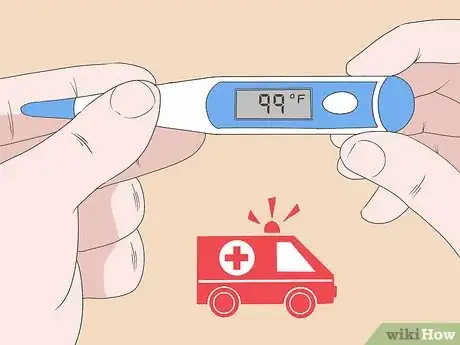This article was medically reviewed by Luba Lee, FNP-BC, MS. Luba Lee, FNP-BC is a Board-Certified Family Nurse Practitioner (FNP) and educator in Tennessee with over a decade of clinical experience. Luba has certifications in Pediatric Advanced Life Support (PALS), Emergency Medicine, Advanced Cardiac Life Support (ACLS), Team Building, and Critical Care Nursing. She received her Master of Science in Nursing (MSN) from the University of Tennessee in 2006.
There are 8 references cited in this article, which can be found at the bottom of the page.
This article has been viewed 15,151 times.
Along with the mouth, the armpit is another popular location for taking a person’s temperature. This is known as the axillary method. It isn't the most accurate way to measure temperature, but it is a good screening to tell if you may have a fever and need to use use a more reliable method. Use a normal digital thermometer to take an armpit temperature. Remove the person’s shirt and make sure their skin is dry. Then press the thermometer into the armpit and wait until it beeps. A temperature reading of 99 °F (37 °C) or above indicates that the person has a fever.[1]
Steps
Preparing for an Accurate Reading
-
1Use a digital thermometer for the most accurate reading. These thermometers are recommended most often because they’re accurate and difficult to break. If you don’t have one in your home, get one from a local pharmacy or order it online.[2]
- Fever strips or thermometer phone apps aren’t accurate, so don’t rely on them for taking someone’s temperature.
- Do not use a glass mercury thermometer. These are fragile and mercury is a toxic substance. Some places have banned these devices because of safety concerns.[3]
-
2Wait at least 20 minutes after they’ve bathed or done physical activity. These activities can raise the skin temperature and give you an inaccurate reading. Wait 20 minutes after these activities so the person’s skin cools down and you can get an accurate reading.[4]
- If you’re taking a child’s temperature, also wait 20 minutes after they’ve been wrapped in a blanket to get an accurate reading.
Advertisement -
3Remove the person’s shirt so the thermometer touches bare skin. Don’t hold the thermometer against clothing or the result won’t be accurate. Have the person remove their shirt before you take their temperature.[5]
- If the person doesn’t want to remove their shirt entirely, they can just pull their arm out of one sleeve so you can access the armpit.
-
4Dry the skin before taking the person’s temperature. Moisture can also inhibit the temperature reading. Use a dry rag or towel and wipe the person’s armpit before taking their temperature.[6]
Measuring the Temperature
-
1Press the start button to activate the thermometer. Most digital thermometers have a start button. Press this button and wait a few seconds. The display may flash until it reads “0.00.” This indicates that the thermometer is ready for use.[7]
- This button may also be labeled "Power" or "Reset."
- Different models may work differently. Always check the instruction manual of your thermometer to find out exactly how to work it.
-
2Place the thermometer directly into the armpit. Look at the person’s armpit and find the area where the skin sinks and forms a little pocket. This is the ideal spot to measure the temperature. Push the tip of the thermometer snuggly into this pocket. Hold it so the end points out from the front of their armpit horizontally.[8]
- Don’t push down so hard that you hurt the person. If they seem uncomfortable, ask if you’re pressing too hard.
-
3Fold the person’s arm down and hold their forearm across their stomach. Press their arm down gently so it cradles the thermometer and holds it in place. Continue holding the thermometer to make sure it doesn’t shift while it’s reading.[9]
- Start over again if the thermometer slips or comes out of place. Hit the reset or start button to clear the thermometer, then put it back into place.
- If you’re taking a child’s temperature, do not leave them unattended while the thermometer works. They may move or take the thermometer out, and you’ll have to take the temperature again.
-
4Hold the thermometer in place until it beeps. Most digital thermometers take a reading in about 10 seconds, then beep to alert you. Wait until you hear this beep. Don’t remove the thermometer beforehand or your reading will be inaccurate.[10]
- Some thermometers may not beep when the reading is complete. Instead, the reading may just flash to indicate it’s finished. Keep an eye on the thermometer display if yours doesn’t beep.
-
5See a doctor if the temperature reads 99 °F (37 °C) or above. Armpit temperature readings are usually lower than oral readings by 0.5-1.0 degree and rectal readings by about 2 degrees. If the armpit reading is above 99 °F (37 °C), then the person probably has a fever.[11]
- If you took a child’s temperature, contact your doctor to see if they should come in for a checkup.
- Doctors recommend checking the person’s temperature again with a more accurate test like an oral thermometer if the armpit reading indicates a fever.
References
- ↑ https://my.clevelandclinic.org/health/symptoms/10880-fever
- ↑ https://my.clevelandclinic.org/health/articles/9959-thermometers-how-to-take-your-temperature
- ↑ https://www.epa.gov/mercury/mercury-thermometers#restictions
- ↑ https://kidshealth.org/en/parents/take-temperature.html
- ↑ https://kidshealth.org/en/parents/take-temperature.html
- ↑ https://www.seattlechildrens.org/conditions/a-z/fever-how-to-take-the-temperature/
- ↑ https://my.clevelandclinic.org/health/articles/9959-thermometers-how-to-take-your-temperature
- ↑ https://youtu.be/nvl1qQfgzuw?t=260
- ↑ https://www.healthlinkbc.ca/healthlinkbc-files/how-take-temperature-children-and-adults

































































Medical Disclaimer
The content of this article is not intended to be a substitute for professional medical advice, examination, diagnosis, or treatment. You should always contact your doctor or other qualified healthcare professional before starting, changing, or stopping any kind of health treatment.
Read More...